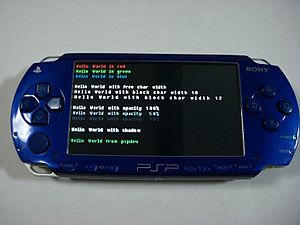PlayStation Portable homebrew

PlayStation Portable homebrew refers to the process of using exploits and hacks to execute unsigned code on the PlayStation Portable (PSP).
History of homebrew
Soon after the PSP was released, hackers began to discover exploits in the PSP that could be used to run unsigned code on the device. Sony released version 1.51 of the PSP firmware in May 2005 to plug the holes that hackers were using to gain access to the device.[1] On 15 June 2005 the hackers distributed the cracked code of the PSP on the internet. Hackers refused to apply updates which would render their hacks unusable so Sony attempted to convince users that there was a benefit to upgrading by including new features in the firmware updates, such as a web browser, and not just security patches to plug the vulnerabilities. BusinessWeek dubbed this the "carrot-and-stick" approach.[2]
In August 2005 Sony released version 2.0 of the firmware which included the web browser, file compatibility updates and other features.[3] Hackers and other homebrew enthusiasts then encountered the first trojan for the PSP. Symantec called this trojan "Trojan.PSPBrick". Users attempting to downgrade their PSP using this software instead found that it was rendered inoperable as this software deleted important system files.[4] Over the course of 2005 Sony released six different versions of the firmware and hackers typically responded to it by downgrading to avoid the new security updates.[2]
In Mid-2006, after several months of problems in defeating the PSP's firmware a file was posted online which allowed new PSPs running firmware version 2.6 to downgrade to 1.5 so they could then be hacked using older methods. This reportedly caused more buzz in the community than any recent official offerings for the device.[5]
Dark_AleX

One of the drawbacks of downgrading the PSP is that new official media may require the presence of a new firmware edition. Dark_AleX[who?] had released a custom firmware called "Dark Alex's Open Edition firmware" or "Custom Firmware (CFW)" which opens the firmware but allows users to use the existing feature set of the current edition. Sony quickly patched the firmware again, continuing the cat-and-mouse game with the hackers and users.[6] In 2006 Sony released six updates to the system firmware and in 2007 they released another six updates.[3] In July 2007 Dark_AleX officially stopped his work on the PSP, citing perceived problems with Sony as one of the reasons for his departure.[7] Some people even suggested that Dark_AleX was paid by Sony not to release any more custom firmware, but Sony denied this.[8]
Custom Firmware allows the running of unsigned code such as homebrew applications and UMD backups, emulators for other consoles, as well as PlayStation games when the disc images are converted into PSP format.[9]
Motivation for homebrew
Hackers have stated that the motivation for unlocking the PSP has nothing to do with piracy, but allowing individuals full access to the products they've purchased and the freedom to do what they want with the item as well as the interest in exploring something unknown.[2][10] Fanjita, a member of the hacker group "N00bz!", stated,
"Everyone has the right to do what they want with their own hardware. Piracy does upset me, and because what we are doing opens the way to piracy it's harder to justify it morally. But our stance on piracy is clear, and we hope to be role models. Sony have never been in touch with me, so I am confident that what we are doing is legal."[6]
Additional features added including the ability to emulate and play the ROMs of other consoles, play homebrew games, share music, print photos, watch videos from streaming sites such as YouTube, and run additional video formats originally unsupported by the device.[2]
Pandora's Battery
Pandora's Battery is a modified PlayStation Portable battery that is the most common way of installing homebrew on PSPs. It has the ability to trigger the service mode which allows you to install homebrew or the official firmware and also has the ability to unbrick a PSP.[11]
References
- ^ "Sony battles hackers over hijacked games". Reuters. 2005-07-06. Retrieved 2008-12-02.
- ^ a b c d Kenji Hall (2005-12-01). "Attack of the Playstation Hackers". BusinessWeek. Retrieved 2008-07-21.
- ^ a b "Playstation.com - Support - System Updates - psp".
- ^ Robert McMillan (2005-10-08). "Trojan Trashes Playstation Portable". PC World. Retrieved 2008-07-22.
- ^ Mike Musgrove (2006-06-06). "Routine Upgrades Are the Bane of 'Homebrew' Enthusiasts". The Washington Post. Retrieved 2008-07-28.
- ^ a b Paul Rubens (2007-02-26). "Three hacker teams unlock the PSP". BBC. Retrieved 2008-07-21.
- ^ Patel, Nilay. "PSP modder extraordinare Dark_AleX calls it quits". engadget. Retrieved 2008-08-05.
- ^ Totilo, Stephen. "Sony Exec Talks New PSP's Upgrades, GPS Attachment, NYC Appeal And More". MTV. Retrieved 2008-08-05.
- ^ Swann, Graham. "Investigating the PSP's PSone emulator". Eurogamer. Retrieved 2008-08-05.
- ^ Mike Musgrove (2005-07-12). "Tapping into Tinkering". The Washington Post. Retrieved 2008-07-22.
- ^ N00bz! "Pandora's Battery", Wednesday, 22 August 2007. Retrieved on 2010-05-16.
